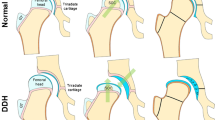Abstract
Introduction
The inability to visualize the sternum tip and T1 vertebra on radiographs may decrease the accuracy of the measurements of cervical sagittal parameters. The object of this study is to investigate the value of MRI to measure cervical sagittal parameters and to compare the data of cervical sagittal parameters on radiographs and MR images.
Materials and methods
Fifty-two asymptomatic adults were recruited. Each subject had both an MRI and radiographs of the cervical spine. Data, including C2–7 lordosis (CL), T1 slope (T1S), thoracic inlet angle (TIA), neck tilt (NT), and T1S minus C2–7 lordosis (T1S-CL), on radiographs and MRI were collected and analyzed.
Results
There were significant differences in CL, T1S, and T1S-CL, between X-ray and MR imaging, but not in TIA and NT. Each of the radiographic cervical sagittal parameters had a significant relationship with the corresponding value on MRI, and the correlation between radiographic and MRI measurement of TIA was the most significant of all parameters.
Conclusions
Positional change may significantly influence most sagittal parameters. Supine MRI cannot substitute for upright cervical radiographs to measure most cervical sagittal parameters except for TIA in an asymptomatic population.


Similar content being viewed by others
References
Lee SH, Kim KT, Seo EM, Suk KS, Kwack YH, Son ES (2012) The influence of thoracic inlet alignment on the craniocervical sagittal balance in asymptomatic adults. Clin Spine Surg 25(2):E41–E47
Lee SH, Son ES, Seo EM, Suk KS, Kim KT (2015) Factors determining cervical spine sagittal balance in asymptomatic adults: correlation with spinopelvic balance and thoracic inlet alignment. Spine J 15(4):705–712
Knott PT, Mardjetko SM, Techy F (2010) The use of the T1 sagittal angle in predicting overall sagittal balance of the spine. Spine J 10(11):994–998
Iyer S, Nemani VM, Nguyen J, Elysee J, Burapachaisri A, Ames CP, Kim HJ (2016) Impact of cervical sagittal alignment parameters on neck disability. Spine 41(5):371–377
Hyun SJ, Kim KJ, Jahng TA, Kim HJ (2016) Relationship between T1 slope and cervical alignment following multilevel posterior cervical fusion surgery: impact of T1 slope minus cervical lordosis. Spine 41(7):E396–E402
Kim TH, Lee SY, Kim YC, Park MS, Kim SW (2013) T1 slope as a predictor of kyphotic alignment change after laminoplasty in patients with cervical myelopathy. Spine 38(16):E992–E997
Jang J, J. S, Lee SH, Min JH, Kim SK, Han KM, Maeng DH (2007) Surgical treatment of failed back surgery syndrome due to sagittal imbalance. Spine 32(26):3081–3087
Park SM, Song KS, Park SH, Kang H, Riew KD (2015) Does whole-spine lateral radiograph with clavicle positioning reflect the correct cervical sagittal alignment? Eur Spine J 24(1):57–62
Jun HS, Chang IB, Song JH, Kim TH, Park MS, Kim SW, Oh JK (2014) Is it possible to evaluate the parameters of cervical sagittal alignment on cervical computed tomographic scans? Spine 39(10):E630–E636
Janusz P, Tyrakowski M, Glowka P, Offoha R, Siemionow K (2015) Influence of cervical spine position on the radiographic parameters of the thoracic inlet alignment. Eur Spine J 24(12):2880–2884
Wang F, Sun X, Mao S, Liu Z, Qiao J, Zhu F, Qiu Y et al (2013) MR imaging may serve as a valid alternative to standing radiography in evaluating the sagittal alignment of the upper thoracic spine. J Spinal Disord Tech 11:582–585
Qiao J, Zhu F, Liu Z, Xu L, Zhu Z, Qian B, Qiu Y et al (2015) Measurement of thoracic inlet alignment on MRI: reliability and the influence of body position. J Spinal Disord Techn. doi:10.1097/BSD.0000000000000306
Author information
Authors and Affiliations
Corresponding author
Ethics declarations
Conflict of interest
The authors declare that they have no conflict of interest.
Funding
This work was sponsored by the Natural Science Foundation of China (81372002, 31170925) and a research grant from the Shanghai Hospital Development Center (SHDC12014102).
Ethical approval
The study was approved by the Ethics Committee of Zhongshan Hospital Fudan University. The manuscript submitted does not contain information about medical device(s)/drug(s).
Electronic supplementary material
Below is the link to the electronic supplementary material.
Rights and permissions
About this article
Cite this article
Xing, R., Zhou, G., Chen, Q. et al. MRI to measure cervical sagittal parameters: a comparison with plain radiographs. Arch Orthop Trauma Surg 137, 451–455 (2017). https://doi.org/10.1007/s00402-017-2639-5
Received:
Published:
Issue Date:
DOI: https://doi.org/10.1007/s00402-017-2639-5




